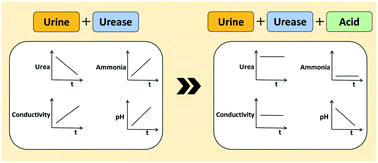当前位置:
X-MOL 学术
›
Environ. Sci.: Water Res. Technol.
›
论文详情
Our official English website, www.x-mol.net, welcomes your feedback! (Note: you will need to create a separate account there.)
Characterization of urea hydrolysis in fresh human urine and inhibition by chemical addition†
Environmental Science: Water Research & Technology ( IF 5 ) Pub Date : 2017-11-03 00:00:00 , DOI: 10.1039/c7ew00271h Hannah Ray 1, 2, 3, 4, 5 , Daniella Saetta 1, 2, 3, 4, 5 , Treavor H. Boyer 1, 2, 3, 4
Environmental Science: Water Research & Technology ( IF 5 ) Pub Date : 2017-11-03 00:00:00 , DOI: 10.1039/c7ew00271h Hannah Ray 1, 2, 3, 4, 5 , Daniella Saetta 1, 2, 3, 4, 5 , Treavor H. Boyer 1, 2, 3, 4
Affiliation

|
Urea hydrolysis is a chemical reaction that occurs in soils, the human body, and in wastewater urine diversion systems. The reaction, which transforms the urea in urine into ammonia and bicarbonate, results in ammonia volatilization and mineral scaling in bathroom fixtures, piping, and storage tanks. Urea hydrolysis is inhibited through different chemical additions that affect the function of the urease enzyme. Bench-scale batch experiments were performed where urea hydrolysis was simulated by adding Jack bean urease to both synthetic and real, fresh human urine. Urea hydrolysis was characterized by measurements of urea concentration, ammonia concentration, conductivity, and pH over time. Conductivity was positively correlated with ammonia concentration and negatively correlated with urea concentration making conductivity a simple, surrogate measurement for tracking the extent of urea hydrolysis. Acetic acid, citric acid, and vinegar were effective at inhibiting urea hydrolysis at concentrations varying from 3.2 × 101 to 1.6 × 102 meq L−1 in both synthetic and real, fresh urine as indicated by the conductivity and pH remaining constant throughout the experiments. Fluoride did not inhibit urea hydrolysis in real, fresh urine at concentrations of 3.2 × 10−2, 3.2 × 10−1, and 3.2 meq L−1. Ionic zinc and ionic silver were ineffective inhibitors of urea hydrolysis due to interactions with phosphate and chloride in urine, respectively, which caused precipitative loss of the metals from solution.
中文翻译:

新鲜人类尿液中尿素水解的特征和化学添加的抑制作用†
尿素水解是发生在土壤,人体和废水尿液分流系统中的化学反应。该反应将尿液中的尿素转化为氨和碳酸氢盐,导致浴室装置,管道和储罐中的氨挥发和矿物质结垢。通过影响尿素酶功能的不同化学添加剂抑制尿素水解。进行了批量试验,其中通过在合成的和真实的新鲜人类尿液中加入Jack bean脲酶来模拟尿素水解。通过随时间测量尿素浓度,氨气浓度,电导率和pH来表征尿素水解。电导率与氨浓度呈正相关,与尿素浓度呈负相关,这使得电导率变得简单,用于跟踪尿素水解程度的替代测量。乙酸,柠檬酸和醋可有效抑制尿素水解,浓度范围为3.2×10在整个实验中,在合成尿液和实际尿液中,电导率和pH值均保持恒定,为1至1.6×10 2 meq L -1。在真实的新鲜尿液中,氟化物在3.2×10 -2,3.2 ×10 -1和3.2 meq L -1的浓度下不会抑制尿素水解。离子锌和离子银分别由于与尿液中的磷酸盐和氯化物相互作用而不能有效抑制尿素水解,这会导致溶液中金属的沉淀损失。
更新日期:2017-11-03
中文翻译:

新鲜人类尿液中尿素水解的特征和化学添加的抑制作用†
尿素水解是发生在土壤,人体和废水尿液分流系统中的化学反应。该反应将尿液中的尿素转化为氨和碳酸氢盐,导致浴室装置,管道和储罐中的氨挥发和矿物质结垢。通过影响尿素酶功能的不同化学添加剂抑制尿素水解。进行了批量试验,其中通过在合成的和真实的新鲜人类尿液中加入Jack bean脲酶来模拟尿素水解。通过随时间测量尿素浓度,氨气浓度,电导率和pH来表征尿素水解。电导率与氨浓度呈正相关,与尿素浓度呈负相关,这使得电导率变得简单,用于跟踪尿素水解程度的替代测量。乙酸,柠檬酸和醋可有效抑制尿素水解,浓度范围为3.2×10在整个实验中,在合成尿液和实际尿液中,电导率和pH值均保持恒定,为1至1.6×10 2 meq L -1。在真实的新鲜尿液中,氟化物在3.2×10 -2,3.2 ×10 -1和3.2 meq L -1的浓度下不会抑制尿素水解。离子锌和离子银分别由于与尿液中的磷酸盐和氯化物相互作用而不能有效抑制尿素水解,这会导致溶液中金属的沉淀损失。



























 京公网安备 11010802027423号
京公网安备 11010802027423号